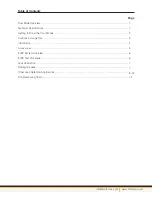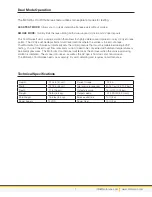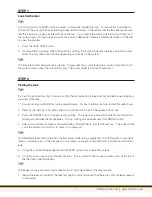
[email protected] www.motorvac.com
STEP 1
Leak Verification
TIP:
A common reason for EVAP codes is a faulty or improperly installed fuel cap. To rule out this possibility do
not disturb the gas cap before performing a leak verification test. If the vehicle fails the leak size test ensure
that the fuel cap is properly installed and redo the test. If you disturb the fuel cap before doing this test and
the system does not show a leak you will not be able to determine if there is an intermittent leak or if the fuel
cap was the problem.
1. Press the LEAK TEST button.
2. Observe the flow gauge. When the ball stops settling, the location indicates the leak size in the system.
Note: This may take a few minutes depending on the size of the system.
TIP:
The flow rate while making smoke is greater. To pressurize the system faster press smoke and allow it to fill
the system until you hear the solenoid cycling. Then press LEAK to perform the leak test.
STEP 2
Finding the leak
TIP:
It is best to perform all testing in calm air, so that the smoke exiting the leak will not be blown away impairing
your view of the leak.
1. Ensure all steps outlined in test setup were followed. For best performance fully unwind the outlet hose.
2. Remove the fuel cap. This allows the air out and the unit to fully fill the system with smoke.
3. Press the SMOKE button to begin creating smoke. The tester has a built in 5 minute timer and will stop
making smoke when the timer expires. To stop making smoke earlier press the SMOKE button.
4. After a solid stream of smoke is observed exiting the fuel fill neck, reinstall the fuel cap. The solenoid will
cycle the system on and off as it comes up to pressure.
TIP:
For intermittent leaks watch the ball in the flow mater while doing a wiggle test on EVAP system components
(hoses, connections etc.) If the ball goes up only when you wiggle a component this indicates an intermittent
leak.
5. Using the supplied halogen light search the EVAP system for smoke exiting a leak.
6. UV light can be used to pinpoint leak locations. This is useful for hard to see locations such as the top of
the fuel tank or behind panels.
TIP:
The longer smoke is allowed to exit a leak more UV dye is deposited at the leak location.
7. Repair the leaks and perform the leak test again to verify repair and that there are not more leaks present
in the system.
7


















